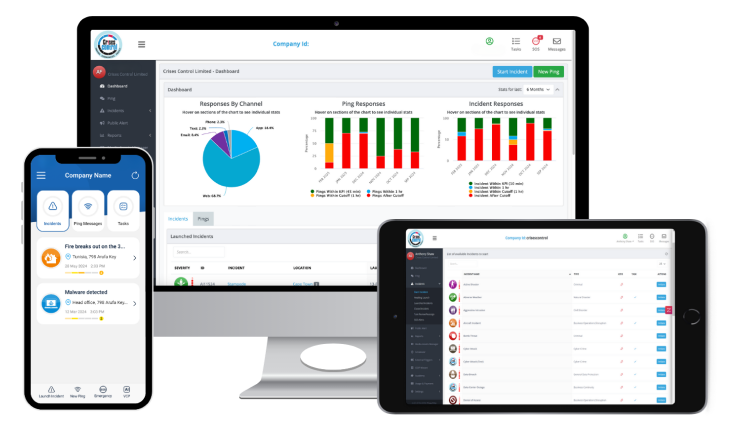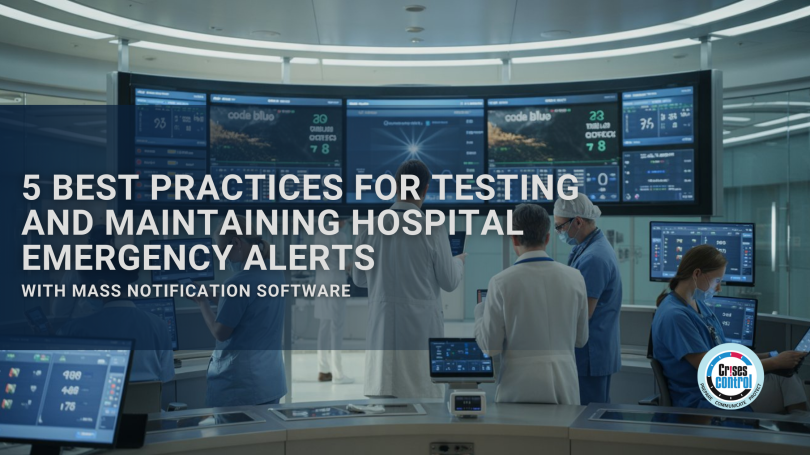Written by Asipe Nokenke | Marketing Assistant
Most crises don’t knock on the door at a polite hour. They slip in when no one’s looking, a server glitch during Sunday lunch, a burst pipe on a public holiday, a power outage while the office is empty. That’s when the clock starts ticking, and the right message needs to reach the right people immediately.
There’s no waiting for someone to hear an overhead page or check their email. No one wastes time figuring out who’s responsible for shutting down the oxygen supply or moving patients from high-risk wards. The plan is already in motion before anyone even reaches the scene. This is what mass notification software brings to healthcare: fast, precise, coordinated action.
The Communication Gap That Costs Hospitals Time and Safety
Even the most well-equipped hospitals can fall victim to slow or fragmented communication.
Think about these all-too-common incidents:
- A critical power failure in the ICU takes too long to reach the facility’s staff.
- Extreme weather is trapping the incoming night shift on blocked roads.
- A chemical spill in the pathology lab goes unreported until patients are already being moved.
These delays don’t come from a lack of urgency; they’re the result of outdated processes, siloed communication systems, and reliance on manual escalation.
Why Testing Hospital Emergency Alerts Isn’t Optional
An emergency alert is only as good as its last test. Without consistent, realistic testing, hospitals risk discovering weaknesses during a real crisis, the worst possible time to find them.
Regular testing:
- Confirms the technology works as intended.
- Keeps staff familiar with their roles.
- Meets compliance requirements for healthcare safety standards.
Best Practice 1: Test All Channels, Not Just One
A hospital emergency alert is rarely sent through one medium alone. SMS, push notifications, email, voice calls, and on-site alarms all play a role.
Tip:
- Run tests that involve every channel your hospital uses.
- Rotate scenarios so different departments get a chance to practise under varied conditions.
How Crises Control Helps:
It allows simultaneous, multi-channel alert testing with built-in reporting to see which messages reached which people and how quickly. Using mass notification software for healthcare ensures alerts are reliable every time.
Best Practice 2: Automate Where Possible
During an emergency, every manual step adds seconds you can’t spare. Automation ensures incidents trigger alerts without waiting for human intervention.
Example:
A sensor detects a drop in temperature in the blood storage unit. The system instantly sends an alert to maintenance, the blood bank supervisor, and hospital leadership with instructions for transferring stock; no one has to pick up a phone.
How Crises Control Helps:
It integrates with Hospital Information Systems, environmental monitors, and security devices to trigger targeted alerts automatically. Mass notification software makes this process seamless and consistent.
Best Practice 3: Train for More Than the Code Names
Code Blue, Code Yellow, Code White staff know the names, but do they all know the full response steps?
Tip:
- Combine code recognition with role-specific instructions.
- Use simulations that walk staff through what to do from alert to resolution.
How Crises Control Helps:
Crises Control enables realistic drills that simulate real incidents without triggering live alerts. Hospitals using mass notification software can ensure training is both safe and effective.
Best Practice 4: Monitor in Real Time
Alerts aren’t just for emergencies already in progress; they’re for warning signs too.
Tip:
- Monitor critical systems continuously.
- Configure alerts for early indicators like rising server temperatures, low water pressure in fire sprinklers, or failing ventilation systems.
How Crises Control Helps:
It connects to monitoring tools so that anomalies trigger instant alerts to the right teams. Real-time monitoring with mass notification software improves response times and reduces risk.
Best Practice 5: Keep a Digital Audit Trail
In healthcare, it’s not enough to respond well; you have to prove it.
Tip:
- Store a complete record of every test, drill, and live incident.
- Map protocols to compliance frameworks like HIPAA, GDPR, or local regulations.
Compliance Snapshot:
| Region | Key Requirements | How Crises Control Supports Compliance |
| North America | HIPAA, Joint Commission, and FDA device regulations | Secure, encrypted alerts with audit-ready logs |
| Europe | GDPR, EU Patient Safety Framework | GDPR-compliant communication, documented response history |
| Middle East | Local health authority disaster management | Multi-language alerts, configurable workflows |
The Chain Reaction of a Well-Tested Alert
With a system like Crises Control, an emergency follows a predictable, coordinated path:
Detection: Incident is identified automatically or manually.
Notification: Alerts sent instantly via multiple channels.
Task Assignment: Everyone knows their role immediately.
Tracking: Each action is logged for visibility and compliance.
Resolution: Incident closed with a full record for audit.
Why Legacy Systems Put Hospitals at Risk
Overhead paging and phone trees can’t:
- Guarantee everyone receives the alert.
- Track who has acted on it.
- Integrate with sensors or monitoring systems.
Modern Mass Notification Software for healthcare replaces uncertainty with speed and clarity.
From Crisis Response to Business Continuity
An emergency rarely happens in isolation; a power outage may come with a cyberattack, or a flood could hit during peak hours.
With Crises Control, business continuity plans sit on the same platform as emergency alerts. This means the transition from “incident mode” to “recovery mode” happens instantly.
Conclusion: Test Today to Save Time Tomorrow
A hospital’s ability to protect patients, staff, and resources depends on the reliability of its emergency alerts. By testing regularly, automating triggers, training effectively, monitoring continuously, and documenting rigorously, hospitals can meet both the demands of real-world crises and the strictest compliance standards.
Crises Control’s mass notification software brings all of these best practices into one integrated platform, making readiness the default, not the exception.
Book your free demo today and see how we can help you strengthen your hospital’s emergency alert system.
Request a FREE Demo

